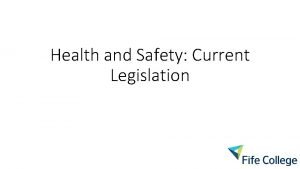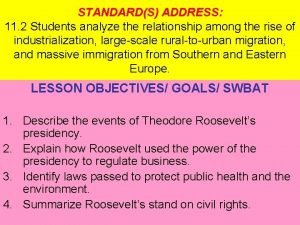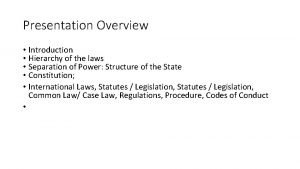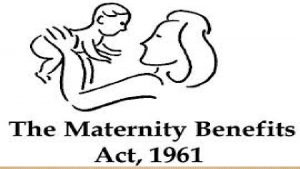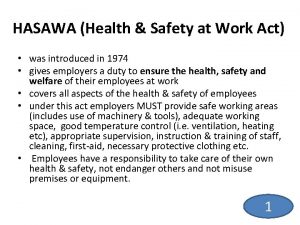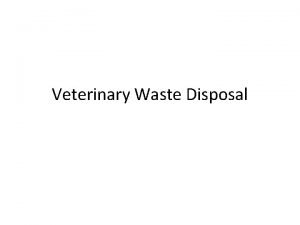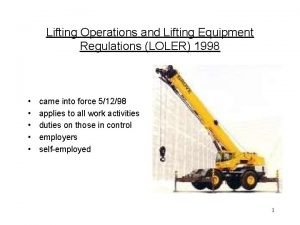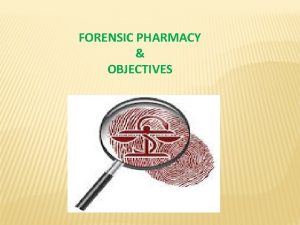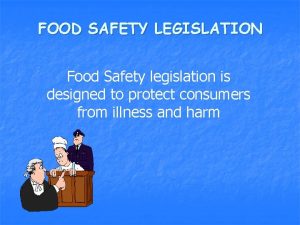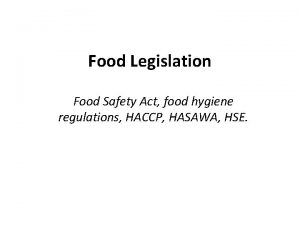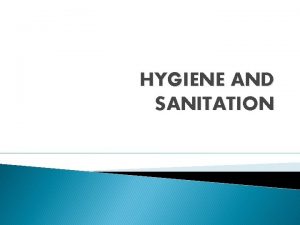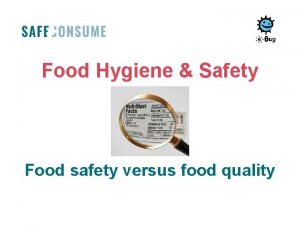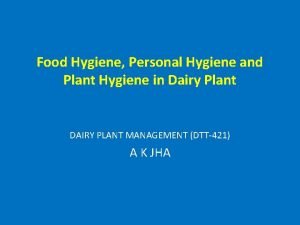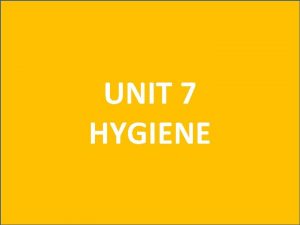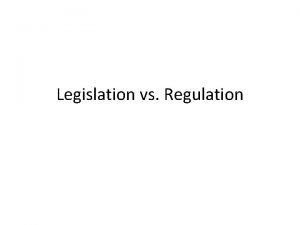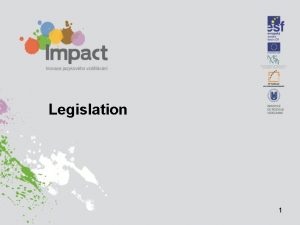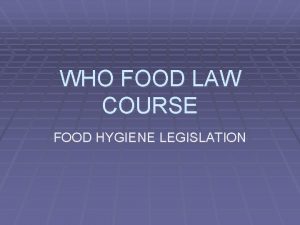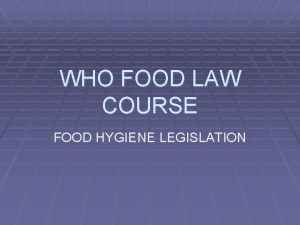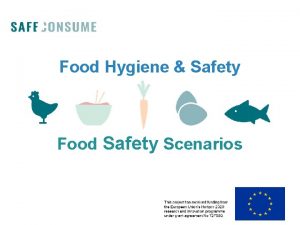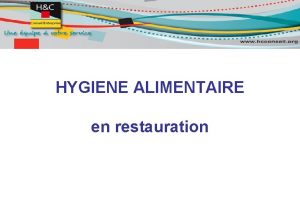FOOD SAFETY HYGIENE FOOD HYGIENE LEGISLATION l l



















- Slides: 19

FOOD SAFETY & HYGIENE

FOOD HYGIENE LEGISLATION l l l The National and European laws controlling food hygiene are: Food Hygiene Regulations (1950 -1989) European Communities (Hygiene of Foodstuffs) Regulations 2000

FOOD HYGIENE REGULATIONS (1950 -89) l l Introduced in 1950. Added to and amended several times. Relates to all sectors of food industry. States requirements regarding food hygiene and food premises. Under these laws certain types of food businesses must register with HSE e. g. hotels & restaurants. Those breaking the law risk prosecution or closure.

FOOD HYGIENE REGULATIONS (1950 -89) Protects the consumer by: l l Prohibiting sale of diseased or contaminated food unfit for human consumption. Requiring that precautions are taken at all stages of food production i. e. importation, processing, distribution etc. , to prevent contamination. Ensuring food premises maintain hygienic conditions regarding equipment, food waste, water supply etc. Ensuring food handlers observe food hygiene and safety rules and follow a HACCP system

(H) SALE OF FOOD & DRUGS ACTS 1875, 1879, 1899, 1936 l Protects consumer against adulteration of foods or fraud. It is an offence to: l l Mix, colour or stain food with an ingredient dangerous to humans e. g. illegal to colour raw meat. Sell food which is not of the nature or quality expected by consumers e. g. injecting beef protein into chicken to increase their weight.

(H) HEALTH ACTS 1947, 53, 70 l l l Prevent danger to public health from importation, manufacture, distribution or sale of food. Control composition of foods that are very important to public health e. g. dairy spreads. This act gives power to Environmental Health Officers (EHOs) to enter premises and prosecute those who break the food laws.

(H) LABELLING REGULATIONS l l Irish Food Labelling Laws are laid down by the European Communities (labelling, presentation & advertising of foodstuffs) Regulations 2002. Nutritional labelling is controlled by The Health (nutrition labelling for foodstuffs) Regulations 1993 and by EU directive (1990).

FOOD SAFETY & HYGIENE Contaminated food may be caused by: l Unhygienic food handlers. l Contact with dirty utensils, surfaces, cloths. l Bacteria transferred from raw to cooked food. l Bad temperature control during storage, preparation, cooking and reheating of food. l Food preparation areas with bad structural standards that are impossible to keep clean.

SAFE FOOD PREPARATION REQUIRES: l l l Personal hygiene for food handlers. Kitchen Hygiene with regard to structures and procedures. Food Hygiene in relation to storage, preparation, cooking and reheating food.

PERSONAL HYGIENE FOR FOOD HANDLERS l l l l Wash hands properly using disinfectant soap and hot water : Before handling food. Switching from raw to cooked food. After using the toilet. After handling waste or pets. After coughing, sneezing or blowing nose. Nails short, clean, no varnish, no jewellery. Cover cuts - coloured plaster. Don’t cough, sneeze, smoke near food. Hair covered - tidy, tied back, hair net. Avoid touching face /hair. Wear protective clothing…apron gloves. Don’t work with food if ill.

KITCHEN HYGIENE – STRUCTURAL l l l All surfaces should be easily cleaned, non-absorbent, without joints or crevices, smooth. Good lighting system. Good ventilation - a cooler dryer room prevents microbes growing. l Clean water supply and proper drainage. l No access for pests e. g. mice, rats cockroaches.

KITCHEN HYGIENE – PROCEDURES l l l l Floors and work surfaces - washed and disinfected regularly. Cloths changed daily & washed frequently. Different cloths for different jobs. All equipment should be thoroughly washed, dried & kept in clean press/ drawer. Pets banned. Bins - small, covered, lined, foot operated, emptied daily, washed and disinfected weekly. Clean cutting surfaces after use. Use separate surfaces for raw and cooked foods. Food storage areas - tidy, cleaned regularly.

FOOD HYGIENE: PREPARATION l l High risk of cross - contamination during preparation because food is in contact with hands, surfaces, equipment & raw food could contaminate cooked food. Also food is in the danger zone i. e. between 5 - 63 ºC. Rules: l Keep danger zone time short. l Prepare food just before cooking. l Prepare raw and cooked food separately. l Wash fruit and vegetables well. Keep away from meat. l Avoid handling food - use utensils/gloves.

FOOD HYGIENE - COOKING Cooking can destroy microbes and their toxins if temperature is high enough for the correct amount of time. Correct temperature and time depends on the food type. Rules: l Use clean equipment in good condition. l Thaw meat and poultry fully before cooking. l Cook properly - centre must reach 82ºC for 20 minutes. l Stir stews, sauces, gravies to spread heat during cooking. Keep above 73 ºC until served. l Cook made - up dishes likes pies very well to avoid cross contamination between ingredients. l Handle food as little as possible.

REHEATING COOKED FOODS Ideally all food should be eaten immediately after cooking, but this is not always possible. When food is reheated, there is a risk that it may be reheated to a temperature at which bacteria can multiply. It may not be a temperature high enough to destroy them. Reheating Rules: l Leftovers - cooled quickly, covered, refrigerated for 2 days maximum. l Reheat quickly to keep time in danger zone minimal. l Heat to 100ºC for 10 minutes to kill microbes. l Never reheat more than once. l If reheating in microwave follow manufacturers instructions for power setting and time.

HYGIENIC FOOD STORAGE Dry Goods Risks: microbial contamination & pests. Rules: l Store food in a cool, dry, well ventilated cupboard or larder. l l Use original container or glass, plastic, metal storage jars. Use in rotation.

HYGIENIC FOOD STORAGE Fresh fruit and vegetables Risks: Bacterial contamination e. g. E. coli. , mould growth, enzyme activity, pests. Rules: l Store according to class text book p 97

HYGIENIC FOOD STORAGE Cook-Chill Foods Risks: bacterial growth, mould growth. Rules: l Check date stamp. l Store below 4ºC. l Use food in rotation. l Fridge not too packed. l Cover food. l Raw below cooked. l Cooled first.

HYGIENIC FOOD STORAGE Frozen foods Risks: bacterial growth if temp of - 18ºC is not maintained. Rules: l Put in freezer as soon as possible after buying. l Freeze fresh food at -25 ºC and store at - 18ºC. l Label with date and use in rotation. l Do not refreeze thawed food.
 Health and safety legislation
Health and safety legislation Summarize roosevelt's approach to environmental problems
Summarize roosevelt's approach to environmental problems Hierarchy of legislation
Hierarchy of legislation National policy and legislation related to child health
National policy and legislation related to child health Subordinate legislation in india
Subordinate legislation in india 2 types of legislation
2 types of legislation Legislation related to maternity benefits
Legislation related to maternity benefits Hasawa health and safety
Hasawa health and safety Traçabilité des soins infirmiers législation
Traçabilité des soins infirmiers législation Dasr 66
Dasr 66 Tourism legislation and professinal ethics
Tourism legislation and professinal ethics Tourism law thailand
Tourism law thailand Legislation
Legislation Legislation vs regulation
Legislation vs regulation Veterinary waste disposal legislation
Veterinary waste disposal legislation Role of rrrlf in promotion and development of libraries
Role of rrrlf in promotion and development of libraries Ict ethics and legislation
Ict ethics and legislation Loler regulations 2018
Loler regulations 2018 Define pharmaceutical jurisprudence
Define pharmaceutical jurisprudence Eu audit legislation
Eu audit legislation
